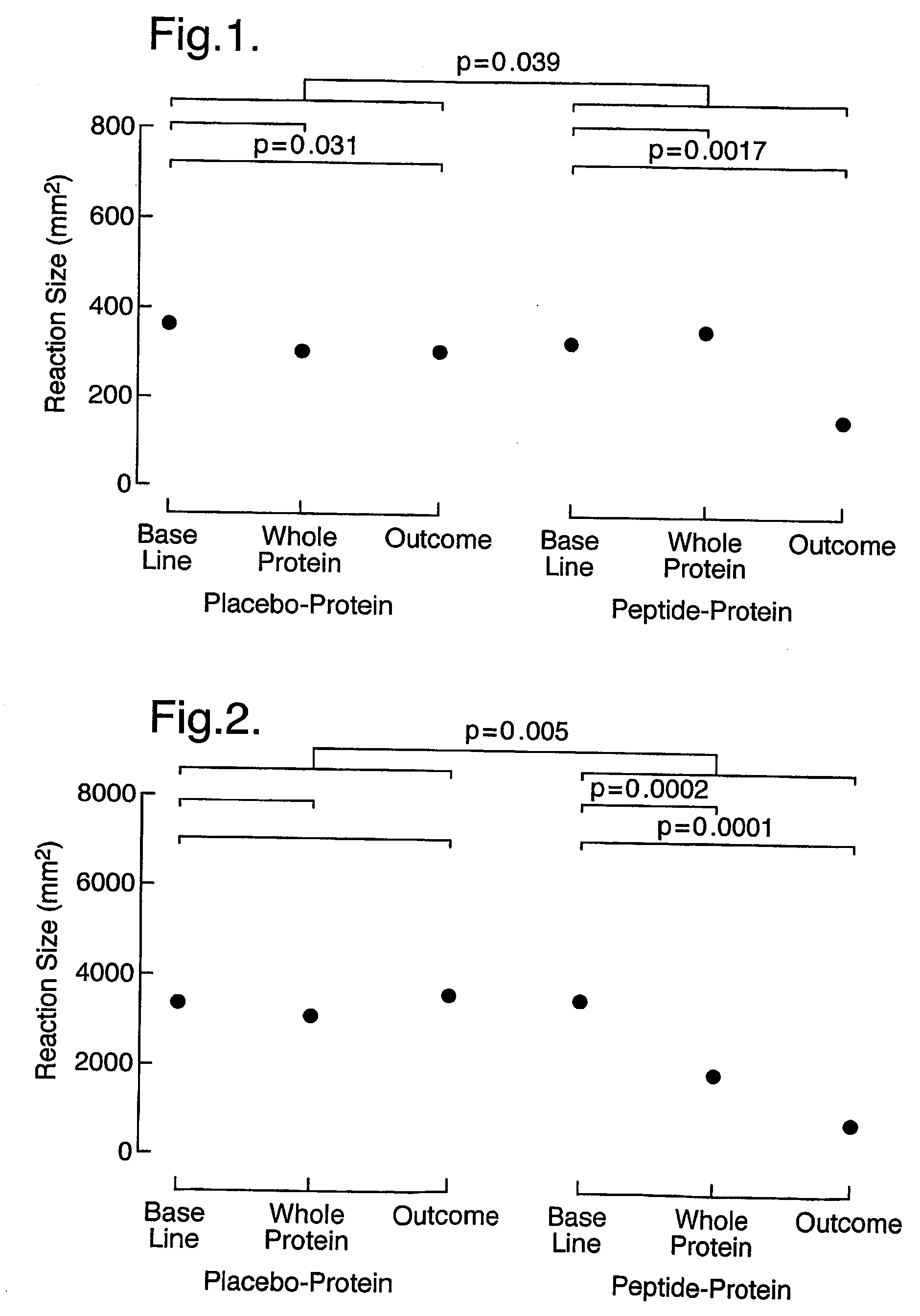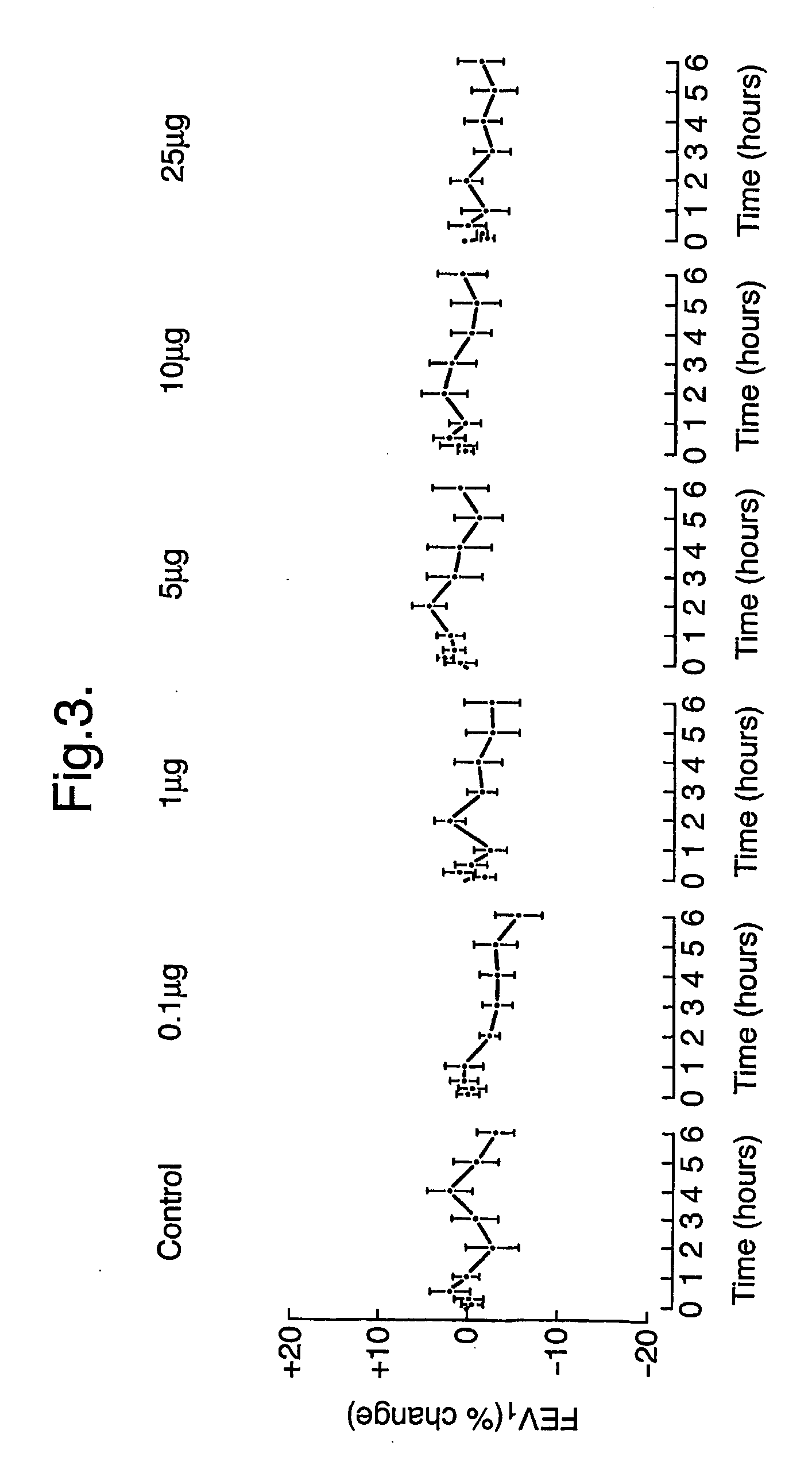Immunotherapeutic methods and systems
a technology of immunotherapy and system, applied in the field of immunotherapy methods and systems, can solve the problems of provoking serious side effects and unsatisfactory treatment, and achieve the effect of reducing the cutaneous late reducing the cutaneous early-phase reaction to fel
- Summary
- Abstract
- Description
- Claims
- Application Information
AI Technical Summary
Benefits of technology
Problems solved by technology
Method used
Image
Examples
example 1
Desensitisation to Fel d 1
[0175] In this example, in a double-blind, placebo-controlled study, 16 subjects were injected intradermally with a mixture of the peptides: EICPAVKRDVDLFLTGT (SEQ ID NO. 1), LFLTGTPDEYVEQVAQY (SEQ ID NO. 2), EQVAQYKALPVVLENA (SEQ ID NO. 3), KALPVVLENARILKNCV (SEQ ID NO. 4), RILKNCVDAKMTEEDKE (SEQ ID NO. 5), KMTEEDKENALSLLDK (SEQ ID NO. 6), KENALSLLDKIYTSPL (SEQ ID NO. 7), LTKVNATEPERTAMKK (SEQ ID NO. 8), TAMKKIQDCYVENGLI (SEQ ID NO. 9), SRVLDGLVMTTISSSK (SEQ ID NO. 10), ISSSKDCMGEAVQNTV (SEQ ID NO. 11), AVQNTVEDLKLNTLGR (SEQ ID NO. 12) (starting at 5 μg of each peptide and increasing in dose until a cumulative dose of 90 μg was achieved) derived from the sequence of the major cat allergen Fel d 1. A control group of 8 individuals received diluent alone (placebo). Subsequently (after approximately one month) they were injected intradermally with the whole protein. Finally after 3-6 months their response to intradermal challenge with the whole protein was a...
example 2
Desensitisation to House Dust Mite Allergen, Der p 1
[0178] In this example, subjects are injected intradermally with a mixture of peptides: EICPAVKRDVDLFLTGT (SEQ ID NO. 1), LFLTGTPDEYVEQVAQY (SEQ ID NO. 2), EQVAQYKALPVVLENA (SEQ ID NO. 3), KALPVVLENARILKNCV (SEQ ID NO. 4), RILKNCVDAKMTEEDKE (SEQ ID NO. 5), KMTEEDKENALSLLDK (SEQ ID NO. 6), KENALSLLDKIYTSPL (SEQ ID NO. 7), LTKVNATEPERTAMKK (SEQ ID NO. 8), TAMKKIQDCYVENGLI (SEQ ID NO. 9), SRVLDGLVMTTISSSK (SEQ ID NO. 10), ISSSKDCMGEAVQNTV (SEQ ID NO. 11), AVQNTVEDLKLNTLGR (SEQ ID NO. 12), and peptides substantially homologous to any one or more of SEQ ID NOs 1-12. (starting at 5 μg of each peptide and increasing in dose until a cumulative dose of 90 μg is achieved) derived from the sequence of the major cat allergen Fel d 1. A control group receives diluent alone (placebo). Subsequently (after approximately one month) they are injected intradermally with the whole Fel d 1 protein which is mixed with the house dust mite protein allerg...
example 3
Desensitisation to House Dust Mite Allergen, Der p 1
[0180] In this example, subjects are injected intradermally with a mixture of peptides: EICPAVKRDVDLFLTGT (SEQ ID NO. 1), LFLTGTPDEYVEQVAQY (SEQ ID NO. 2), EQVAQYKALPVVLENA (SEQ ID NO. 3), KALPVVLENARILKNCV (SEQ ID NO. 4), RILKNCVDAKMTEEDKE (SEQ ID NO. 5), KMTEEDKENALSLLDK (SEQ ID NO. 6), KENALSLLDKIYTSPL (SEQ ID NO. 7), LTKVNATEPERTAMKK (SEQ ID NO. 8), TAMKKIQDCYVENGLI (SEQ ID NO. 9), SRVLDGLVMTTISSSK (SEQ ID NO. 10), ISSSKDCMGEAVQNTV (SEQ ID NO. 11), AVQNTVEDLKLNTLGR (SEQ ID NO. 12), and peptides substantially homologous to any one or more of SEQ ID NOs 1-12. (starting at 5 μg of each peptide and increasing in dose until a cumulative dose of 90 μg is achieved) derived from the sequence of the major cat allergen Fel d 1. A control group receives diluent alone (placebo). Subsequently (after approximately one month) they are injected intradermally with an emulsion containing the Fel d 1 peptides administered previously together wit...
PUM
| Property | Measurement | Unit |
|---|---|---|
| Composition | aaaaa | aaaaa |
| Time | aaaaa | aaaaa |
Abstract
Description
Claims
Application Information
 Login to View More
Login to View More - R&D
- Intellectual Property
- Life Sciences
- Materials
- Tech Scout
- Unparalleled Data Quality
- Higher Quality Content
- 60% Fewer Hallucinations
Browse by: Latest US Patents, China's latest patents, Technical Efficacy Thesaurus, Application Domain, Technology Topic, Popular Technical Reports.
© 2025 PatSnap. All rights reserved.Legal|Privacy policy|Modern Slavery Act Transparency Statement|Sitemap|About US| Contact US: help@patsnap.com


